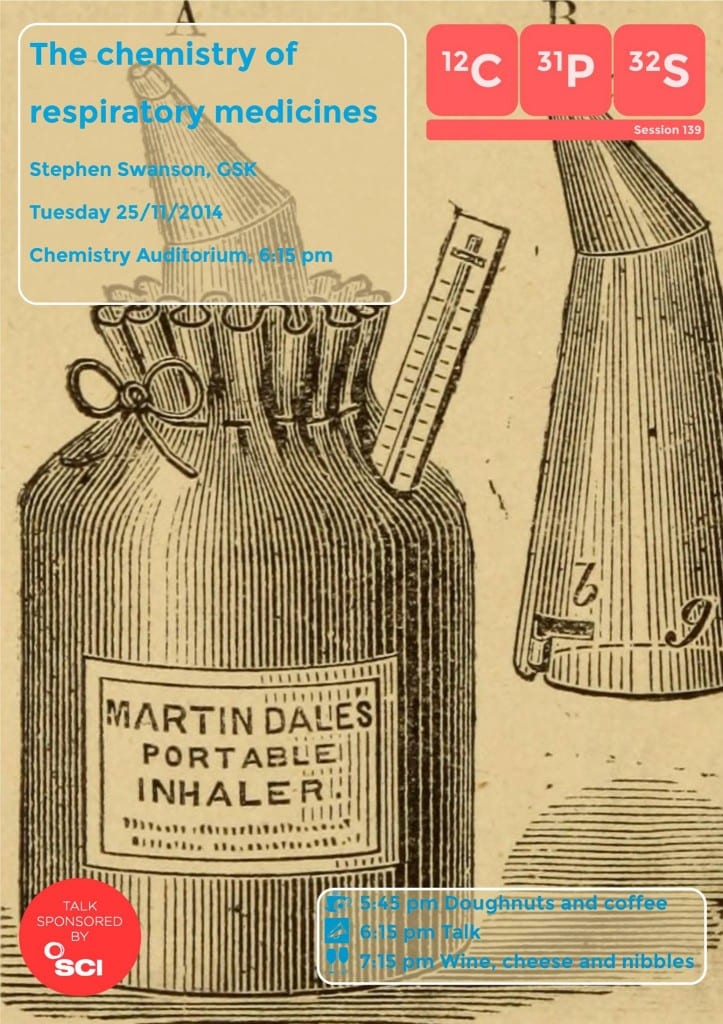The Chemistry of Respiratory Medicines – CPS Talk 25/11/14
By Penny Carmichael, on 4 December 2014
– Article by Stephen Leach
Stephen Swanson, a research and development manager of Respiratory Medicine at Glaxo Smith Kline arrived at the CPS with tales of drugs. A veteran of 32 years in medicinal chemistry, he must know the world of corporate chemistry well. Amongst the ranks were mutterings of dissent with regards to the ethics of the pharmaceutical industry, however he focussed on the science and glossed over the business. A costly business in which R&D is a serious financial strain on the pockets of the investors; <5% of research projects ever become a publicly available drug. This means sadly the successful molecules foot the bill for the research cost of all the unsuccessful ones.
The development of a drug is a rocky road; scientists, lawyers and business people all at some point chaperone these small molecules on their way from the lab into our bodies. Stephen was firmly driven by the desire to improve therapies and gave us an account of the maturation of Salmeterol, a much improved commercially available asthma drug.
It all starts with a target in the body, in this case the adrenergic receptors. The function of these receptors are fairly well understood, they are the targets for natural hormones such as adrenalin. If something makes you jump, you may feel the effect of these receptors; adrenaline in the bloodstream alters a number of bodily functions simultaneously. Digestion is de-prioritised and the bowels are put on stand-by, (unless it REALLY made you jump). The heart speeds up and in seconds the body is poised for fight or flight. Adrenergic receptors are a type of G protein and they come in 5 types. For the treatment of an asthma attack, the drug molecule must target a single one of these receptors: β2. This prevents an asthma sufferer from getting the full raft of adrenergic responses during an attack. What they may especially need is bronchial dilation so that they can breathe properly, β2 stimulates such a response. Hence GSK want a molecule that acts as an agonist for β2 but preferably not the others.
Adrenaline is a simple looking molecule and is an agonist for all the adrenergic receptors. If you are feeling whimsical, look up the following molecules in the given order to see exactly how the molecule was changed over the course of 20 years.
Isoprenaline was the first attempt, it is pretty similar to adrenaline and was developed into a therapy. However it wasn’t selective enough to β2 and had some dangerous effects on the heart as it was acting as agonist for β1. In addition the body would quickly metabolise the molecule, this required more frequent dosage and raised the risk of overdose. This was solved by the addition of a large lipophilic component, giving Salbutamol. The selectivity had been improved but the metabolism problem had not. Next up was Salmeterol which was the ideal candidate, selective and long lasting, even the metabolite remained selective for β2.
Each of these was a marketed drug in its own right but at each iteration the therapy was becoming less dangerous and more effective.
Regardless of the rights and wrongs of a privatised drug industry, which may not always appear conscientious, we’ve come a long way since trepanning, let’s be grateful for that.
 Close
Close



 Subscribe to this blog!
Subscribe to this blog!